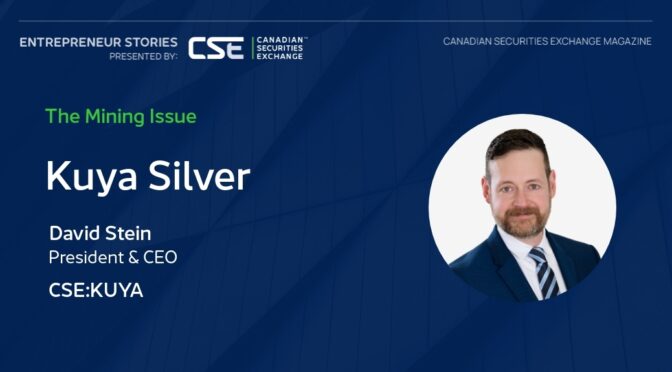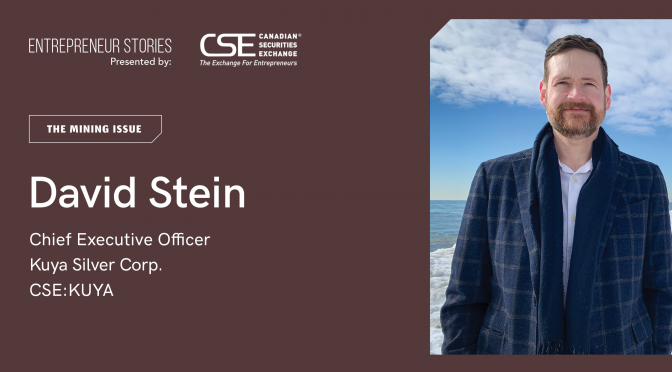When the founders of Kuya Silver (CSE:KUYA) first came across the Bethania Mine in the Peruvian Andes, the idle site brought to mind assets that some of the world’s top silver companies had put into production when they were small and growing.
One of those founders, now Kuya President and Chief Executive Officer David Stein, saw the potential right away, drawing on nine years of experience as a Bay Street mining analyst and seven years in private equity.
Knowledge of what investors want to see in a successful company gave Stein the confidence to make the acquisition of Bethania in 2017 and build assets around the flagship project to achieve an attractive corporate profile.
Bethania was on care and maintenance when Stein and Christian Aramayo, Kuya Co-Founder and Chief Operating Officer, first encountered it. At the time, the mine was owned by a Peruvian family and had just two shareholders.
“What I liked about Bethania was that it really reminded me of the early days of some of the big silver mining companies, like First Majestic, which started in Mexico with a single mine,” says Stein, who recalls being the first analyst to cover First Majestic in the early 2000s.
“So, I knew what kind of business model and value could be created with a high-grade silver mine like this. And you had all the hallmarks of a great mine, including good grades, which mean your costs are going to be low, and tremendous exploration potential. The previous owners did not do any real exploration – they were just following veins that are very obviously open.”
Stein and Aramayo sensed that modern exploration techniques had a high chance of proving up a significant deposit at the property and that the exploration could take place in tandem with production.
“In my view, the best junior mining companies give the market two things: production growth and resource growth, at the same time ideally,” says Stein. “Those are the companies that will outperform their peers, and I felt like Bethania had the opportunity to do that by starting up production and then growing it incrementally, with exploration potentially offering huge resource upside.”
A lot of the needed infrastructure was already in place. And Peru, of course, is a country where many of the world’s top mining companies run successful operations.
Following an initial investment and earn-in deal as a private company, funded mainly by Stein, Kuya went public and raised enough money to buy all of the shares of Bethania’s Peruvian owners at the end of 2020, giving Kuya 100% ownership.
The company added to its local land position soon after, with the project eventually reaching a total of 4,300 hectares. The mine itself sits on about 15 hectares, says Stein. “It’s only a tiny portion of this huge land package that has not been explored by drilling.”
Under Kuya’s control, Bethania has transitioned from sitting dormant to once again being in production, with operations restarted in May of this year and the first sale of silver-lead concentrate completed in October.
While Kuya is leveraging a toll milling model to process its ore, it has all the permits it needs to establish its own mill. A company-owned mill will likely have to wait until 2027, though, as Kuya first intends to build up its production rate and operating cash flow.
As an initial target, Stein and Aramayo aim to increase throughput to 350 tonnes per day.
Stein expects that current all-in sustaining costs will be around US$15 per ounce factoring in the cost for toll milling. This is higher than the sub-$10 estimate in Bethania’s preliminary economic assessment (PEA), but with silver prices north of $30, there’s plenty of headroom.
“When we hit our target run rate, you’re looking at 1.5 million ounces of silver production per year and some pretty meaningful cash flow,” says Stein. “It’s looking in the order of almost US$2 million a month at current silver prices.”
Plans call for allocating cash flow from mining sales to growing the deposit via exploration.
In addition to the 4,000-plus hectare site in the Andes, Kuya has also been building a potential district-size asset in Northern Ontario, which it calls the Silver Kings Project.
Here, the company has 13,000 hectares located in one of Ontario’s most prolific silver mining camps, near the historic mining town of Cobalt.
“My experience when I was an analyst was that the market is always looking for growth,” says Stein. “And if you don’t have it now, you have to buy it later and usually pay more for it. Silver Kings is an attractive risk-return for us in that sense.”
Exploration remains central to Kuya’s growth story with so little of Bethania explored to date, and Silver Kings being an earlier stage project.
While the market is not attributing significant value to the Ontario asset yet, the team made the acquisition and has consolidated more land because they see high-grade silver potential.
Geologically, Silver Kings is very different from Bethania, right down to the by-products, which in Ontario would include cobalt.
The district has seen little to no silver exploration for over 40 years, but Kuya’s geologists have identified dozens of targets.
And because it is in Canada, Kuya can minimize dilution by taking advantage of flow-through financing to fund exploration.
“I feel like it’s always a good idea to line up a company’s next growth opportunity,” says Stein.
“As we grow in Peru with Bethania for the next five years, people will start to wonder what’s next, and the nice thing is we already have the next thing potentially with the Ontario project.”
As for growing Bethania, the initial focus is enlarging the resource. There has only ever been drilling to a depth of about 200 metres from surface, and veins are open both at depth and along strike.
Exploration drilling will initially focus on three nearby zones with historical mining activity.
“We feel these have the potential to add significant tonnage in the future,” the CEO says, adding that Kuya could conduct US$20 million to US$30 million in exploration in the district over the next several years “and really show that there’s a much bigger project there.”
If current plans come to fruition, there should be enough money in the bank to start exploration in the second quarter of 2025.
“Once we start, the drills will never stop. We’ll keep drilling and exploring these various targets for many years to come,” explains Stein.
And building a mill in a few years would lower costs and risk, improve recoveries and allow expansion beyond 350 tonnes per day.
Environmental, social and governance (ESG) practices will also be incorporated in Bethania’s expansion.
As an underground mine, Stein says Bethania’s environmental footprint is relatively small, while the mill has been designed to recycle water and comes with plans to connect to Peru’s hydroelectric grid for clean energy.
On the social side, Kuya maintains strong ties with the local community, providing jobs and sharing economic benefits. “The community has been very supportive,” Stein notes.
With silver prices showing upward momentum, rising from US$23 per ounce at the start of 2024 to around US$30 lately, Kuya could benefit from market dynamics as well as its own actions.
“If silver prices rise to $50 or $60, the upside is enormous,” Stein concludes.
This story was featured in Canadian Securities Exchange Magazine.
Learn more about Kuya Silver at https://www.kuyasilver.com/.


